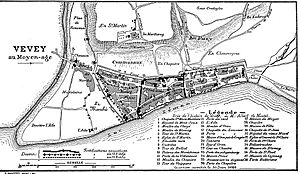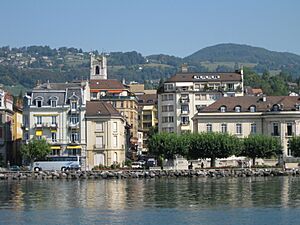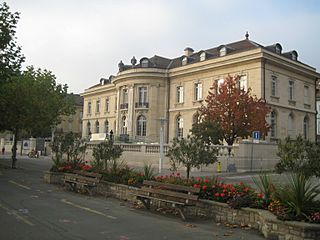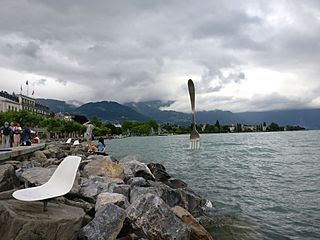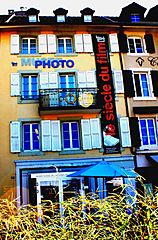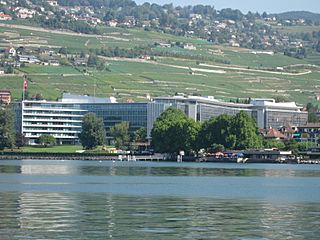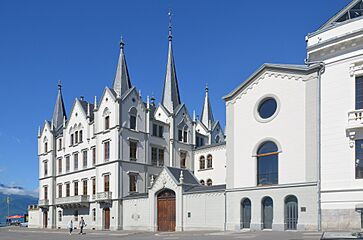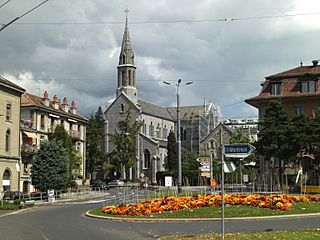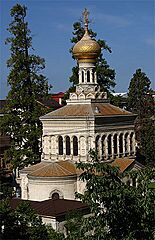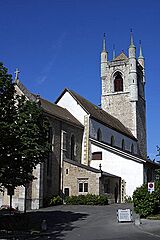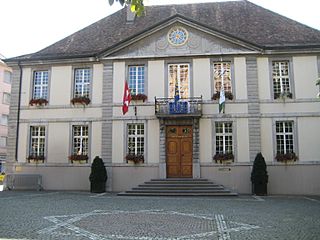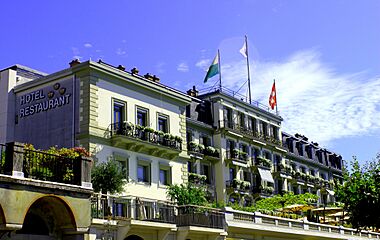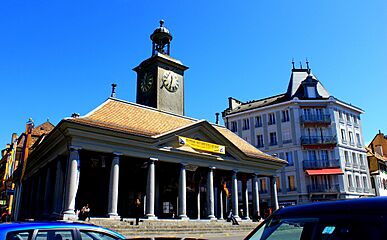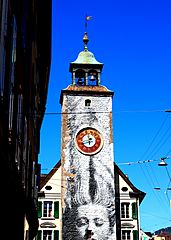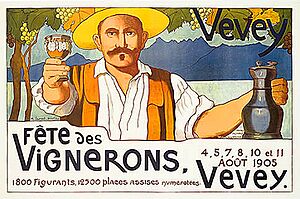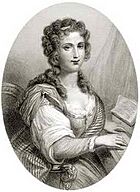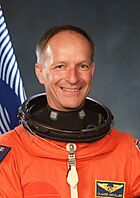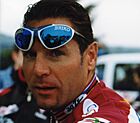Vevey facts for kids
Quick facts for kids
Vevey
|
||
|---|---|---|
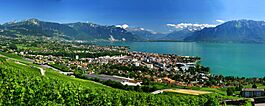
Vevey and Lake Geneva
|
||
|
||
| Country | Switzerland | |
| Canton | Vaud | |
| District | Riviera-Pays-d'Enhaut | |
| Area | ||
| • Total | 2.4 km2 (0.9 sq mi) | |
| Elevation | 383 m (1,257 ft) | |
| Population
(Dec 2020 )
|
||
| • Total | 19,752 | |
| • Density | 8,230/km2 (21,300/sq mi) | |
| Postal code |
1800
|
|
| Surrounded by | Corseaux, Corsier-sur-Vevey, La Tour-de-Peilz, Saint-Légier-La Chiésaz | |
Vevey is a lovely town in Switzerland. It is located in the canton of Vaud. You can find it on the north shore of Lake Leman, which is also known as Lake Geneva. It's not far from the city of Lausanne.
Vevey used to be the main town of its own district until 2006. Now, it is part of the Riviera-Pays-d'Enhaut District. People in Vevey mostly speak French, as it is in the French-speaking area of Switzerland.
This town is famous for a few things! It's the home of Nestlé, a huge international food and drink company. Nestlé was started right here in 1867. Also, milk chocolate was invented in Vevey in 1875 by Daniel Peter, with help from Henri Nestlé. The famous actor and comedian Charlie Chaplin lived in Vevey from 1952 until he passed away in 1977.
Contents
- History of Vevey
- Geography of Vevey
- Vevey's Coat of Arms
- People of Vevey (Demographics)
- Important Places in Vevey
- Main Sights and Attractions
- Economy of Vevey
- Religion in Vevey
- Weather in Vevey
- Education in Vevey
- Sports in Vevey
- Healthcare in Vevey
- Clara Haskil Piano Competition
- Vevey in Modern Music
- Images for kids
- Notable People from Vevey
- Famous Residents (Past and Present)
- Transportation in Vevey
- International Connections
- See also
History of Vevey
People have lived in Vevey for a very long time. A settlement built on stilts over water existed here about 4,000 years ago!
During the time of Ancient Rome, the town was called Viviscus or Vibiscum. The ancient Greek astronomer Ptolemy was the first to write about it, calling it Ouikos. In the Middle Ages, Vevey was a stop on the Via Francigena, an important road for travelers.
Later, the town was controlled by the bishopric of Lausanne and then by the Blonay family. In the 1660s, some of the people who had ordered the death of King Charles I of England came to Vevey. They found safety here with the help of the Bernese government.
Vevey became very successful after the Vaud Revolution in 1798. In the 1800s, industries like machine building, food (Nestlé), and tobacco grew here.
Vevey has been a big center for the Swiss chocolate industry since the 1700s. The Cailler chocolate factory opened in 1819. And, as you know, milk chocolate was created here by Daniel Peter in 1875!
Geography of Vevey
Vevey covers an area of about 2.4 square kilometers (about 0.9 square miles). A small part of this land is used for farming, and some is covered by forests. Most of the area, about 90%, is built up with buildings and roads.
The town is located on Lake Geneva, which is a beautiful feature of its landscape. Vevey was the main town of the Vevey District until 2006. After that, it became the capital of the new Riviera-Pays-d'Enhaut District.
Vevey's Coat of Arms
The blazon (description) of Vevey's coat of arms is quite unique. It shows two letters "V" that are linked together. They are shown in gold on a blue background, and blue on a gold background.
People of Vevey (Demographics)
Vevey has a population of about 17,287 people (as of 2007). Many people from other countries live here, making the town very diverse. Over the last 10 years, the number of people living in Vevey has grown quite a bit.
Most people in Vevey speak French. Italian and Portuguese are the next most common languages spoken.
The town has a good mix of ages. There are many children and teenagers, as well as adults and older people. This shows that Vevey is a place where families can grow and thrive.
Important Places in Vevey
There are 14 special buildings and places in Vevey that are recognized as important Swiss heritage sites. These include:
- Four museums: the Alimentarium (a food museum), the Museum of the Winegrowers' Brotherhood, the Musée Jenisch (an art museum), and the Swiss Camera Museum.
- Three churches: the Roman Catholic Church of Notre-Dame, the Orthodox Church of Saint Barbara, and the Swiss Reformed Church of Saint-Martin.
- Other important buildings: the main office of Nestlé, Aile Castle, the City Hall, and the beautiful Hôtel des Trois-Couronnes.
Heritage Gallery
Main Sights and Attractions
The Grande Place is the big main square in Vevey. It has a large old granary called La Grenette, built in 1803. Behind it is a restaurant called La Clef, where the famous writer Jean-Jacques Rousseau used to eat. You can still see the table where he sat!
St Martin's Church is a short walk from the Grande Place. It's interesting because some of the people who were involved in the death of King Charles I of England are buried there. One of them was Edmund Ludlow, who came to Vevey to escape after Oliver Cromwell died.
You might also notice a giant fork sticking out of Lake Geneva near the shore. This fork was first put there in 1995 as a temporary art piece. People loved it so much that it was brought back in 2007 and allowed to stay. It has now become a symbol of Vevey!
Festivals in Vevey
Vevey hosts a very special event called the Winegrowers' Festival (Fête des Vignerons). It's organized by the Brotherhood of Winegrowers and happens only about four or five times each century. This means it's a once-in-a-generation event! It celebrates the town's long history of wine-growing.
For the festival, a huge arena is built in the Grande Place, which can hold 16,000 people. This marketplace is actually the second-biggest in Europe! The last festivals were in 1927, 1955, 1977, 1999, and 2019.
Local Markets
Vevey is also known for its lively market held on Tuesday and Saturday mornings. During summer, from July to August, there are special "Folk Markets" called Marchés Folkloriques. Up to 2,000 visitors come each Saturday!
At these markets, you can buy a wine glass and enjoy local wines. You can also listen to brass bands and Swiss folk music. It's a great chance to see traditional craftsmen at work.
Economy of Vevey
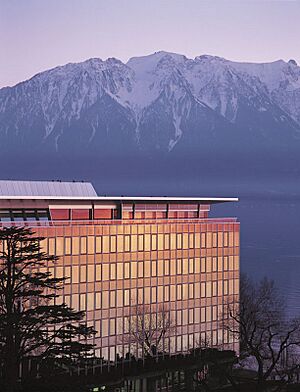
Vevey is an important economic center. Many people work in the service industry, which includes things like sales, hotels, restaurants, and healthcare. There are also jobs in manufacturing and construction.
The town is a "net importer" of workers. This means that more people travel into Vevey for work than leave Vevey to work elsewhere. This shows that Vevey has many job opportunities. Many people use public transportation or private cars to get to work.
Religion in Vevey
Vevey has a mix of different religions. Many people are Roman Catholic or belong to the Swiss Reformed Church. There are also people who are Orthodox Christian, Muslim, Jewish, Buddhist, and Hindu. Some people do not belong to any church.
Weather in Vevey
Vevey usually has about 124 days of rain or snow each year. The wettest month is August, and the driest month is February.
Education in Vevey
Education is important in Vevey. Many adults have completed high school, and a good number have gone on to higher education at a university or a specialized college.
The school system in Vaud canton offers pre-school, primary school (four years), and lower secondary school (six years). Vevey has many students in these programs.
Vevey is home to several museums that are also educational. The Alimentarium is a food museum, the Musée Jenisch is an art museum, and the Musée suisse de l'appareil photo is a photography museum. These museums attract many visitors each year.
The town also has a public library, the Bibliothèque médiathèque municipale. It has tens of thousands of books and other media for people to borrow.
Sports in Vevey
Vevey has its own football (soccer) club, FC Vevey-Sports 05. There's also a rowing club called Club Aviron Vevey, or CAVy. They are known as one of the best rowing clubs in the French-speaking part of Switzerland.
Healthcare in Vevey
Vevey has hospitals that provide healthcare services to the community.
Clara Haskil Piano Competition
The Clara Haskil International Piano Competition is held in Vevey every two years. This competition honors the memory of Clara Haskil, a famous Swiss pianist who lived in Vevey from 1942 until she passed away in 1960.
Vevey in Modern Music
Vevey has even been mentioned in music! Rick Wakeman, the keyboard player for the band Yes, recorded parts of his music on the pipe organ in St. Martin's Church in Vevey. He even has a song called "Vevey (Revisited)".
The town and the nearby vineyards of Lavaux are also mentioned in the song Lavaux by the artist Prince.
Images for kids
Notable People from Vevey
Many interesting people were born in Vevey or lived there:
- Françoise-Louise de Warens (1699–1762) - A woman who helped the famous writer Jean-Jacques Rousseau.
- François-Louis Cailler (1796–1852) - A chocolatier, meaning he made and sold chocolate.
- Alexandre Calame (1810–1864) - A well-known painter.
- Ernest Ansermet (1883–1969) - A famous orchestral conductor.
- Jean-Pascal Delamuraz (1936–1998) - A politician who was a member of the Swiss Federal Council.
- Claude Nicollier (born 1944) - The first astronaut from Switzerland!
- RAF Camora (born 1984) - A rapper.
- Sports Stars
- Pascal Richard (born 1964) - A former racing cyclist who won a gold medal at the 1996 Summer Olympics.
- Thabo Sefolosha (born 1984) - A professional basketball player.
- Natacha Gachnang (born 1987) - A racing car driver.
Famous Residents (Past and Present)


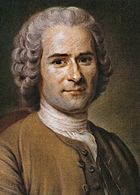
Many famous people have lived in Vevey:
- Charlie Chaplin (1889–1977) - The British comedian and actor. He lived nearby in Corsier-sur-Vevey.
- Fyodor Dostoevsky (1821–1881) - A famous Russian novelist.
- Friedrich Engels (1820–1895) - A German philosopher.
- Graham Greene (1904–1991) - A British writer.
- Clara Haskil (1895–1960) - The Swiss Romanian classical pianist.
- Victor Hugo (1802–1885) - A famous French poet and writer.
- Edouard Jeanneret (1887–1965) - A well-known Swiss architect.
- James Mason (1909–1984) - A famous actor. He lived nearby in Corsier-sur-Vevey.
- Daniel Peter (1836–1919) - The inventor of the milk chocolate bar.
- Jean-Jacques Rousseau (1712–1778) - A Swiss writer and philosopher.
- Henryk Sienkiewicz (1846–1916) - A Polish writer who won the Nobel Prize in Literature. You can see his statue in Vevey.
- Shania Twain (born 1965) - The Canadian country singer-songwriter.
Transportation in Vevey
Vevey has good transportation links:
- The Vevey railway station was the first train station to be "automated" in 1956. Trains run often to places like Lausanne, Geneva, and Montreux.
- The Vevey–Chardonne–Mont Pèlerin funicular is a special train that takes you up to the top of Mont Pèlerin.
- The Vevey–Villeneuve trolleybus line is a unique electric bus line. It runs every 10 minutes during the day, connecting Vevey with nearby towns.
- There are also regular bus lines and late-night buses.
- You can also travel by boat on Lake Geneva. Boats go to many major towns around the lake.
International Connections
Vevey has "twin town" or "sister city" relationships with other towns around the world. This means they share cultural and friendly ties.
|
Vevey also has a connection with Vevay, Indiana, in the United States.
See also
 In Spanish: Vevey para niños
In Spanish: Vevey para niños





